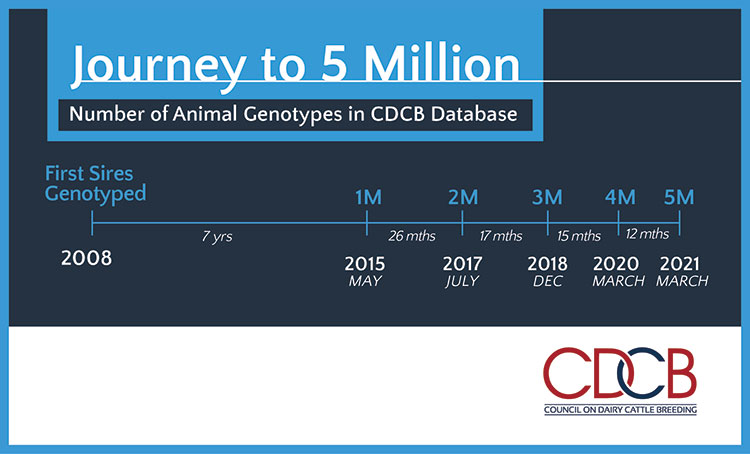A new milestone was achieved on March 5. That’s when the 5 millionth individual genotype was recorded in the national dairy cooperator database. This database of both genotypic and phenotypic — or animal performance data — information is managed by the Council on Dairy Cattle Breeding (CDCB). The CDCB calculates the U.S. dairy genetic evaluations and provides management benchmarks.
The U.S. database is revered by animal breeders worldwide. Not only is it the world’s largest database of animal information, but this database also has a highly sophisticated data quality assurance process. This strategic asset is possible through the commitment of many U.S. dairy organizations and like-minded international partners.
Quality data results in quality evaluations
A sophisticated process is in place to assure high data quality into the U.S. database. It is this combination of data quantity and quality that provides increasingly accurate predictions of genetic merit.
Genomic nominators and genotyping labs must meet CDCB quality certification standards before they can nominate animals and submit genotypes into the national cooperator database. CDCB provides monthly reports to each nominator and lab, detailing performance against established key metrics. Additionally, performance audits are conducted annually. Once the genotypes are transferred, CDCB performs a series of checks to ensure genotypes are usable and assigned to the correct animal. Then, CDCB calculates the genomic evaluations for genotyped animals.

Rapid adoption of genomic testing
The first U.S. Holstein sires were genotyped in 2008. After seven years, the 1 millionth genotype was added to the national cooperator database in May 2015. Since then, the database has grown more rapidly as genomic testing has been readily adopted. In the most recent 12 months, 1 million animal genotypes have been submitted to the CDCB.
Genotyping of females has soared in recent years, as genomic evaluations have become an indispensable tool for mating, culling and herd management decisions in more herds worldwide. The vast majority — 90% of genotyped animals — in the CDCB database are female. By breed, 86% of all genotypes are Holstein and 12% are Jersey.
Genetic gain, new traits enabled through genomics
Since 2009, dairy producers around the globe have been able to use high-ranking U.S. genomic sires. In 2020, young genomic sires accounted for 74% of the inseminations in U.S. herds that record through Dairy Herd Information (DHI).
This broad adoption of genotyping and genomic selection has resulted in a doubling of the annual rates of genetic gain in U.S. Holsteins. This progress is due to the shortened generation interval (age of parents when offspring are born) and enhanced selection accuracy (reliability).
Genomics has created the opportunity to develop new traits that contribute to improved animal health and economics. Relevant performance, or phenotypic, data can be measured on a smaller group of genotyped animals, called the reference population, and then genomic breeding values can be predicted for all animals that have been genotyped. In April 2018, CDCB first published six traits that measure the genetic resistance to disease, including displaced abomasum, ketosis, mastitis, metritis, milk fever, and retained placenta. In December 2020, Feed Saved was introduced as a new tool to predict feed efficiency of individual animals, enable producers to save on feed costs, and help reduce dairy’s environmental footprint.
Genomic technology has resulted in tremendous genetic gains, more accurate and earlier prediction of animals’ genetic merit, changes in herd culling and breeding strategies, and several new, economically-important traits.
True collaborative effort
Dairy producers, genotyping labs, and genomic nominators — like breed associations and genetic companies — are critical collaborators, providing genotypes to the national cooperator database. This genotypic data combines with phenotypic data that has been collected for decades by CDCB collaborators including Dairy Records Providers (DRPs), Dairy Records Processing Centers (DRPCs), the National Association of Animal Breeders (NAAB), and Purebred Dairy Cattle Association (PDCA). The United States Department of Agriculture (USDA) established the database, which was transferred to CDCB in 2013, and USDA remains a key partner through world-renowned research at the Animal Genomics and Improvement Laboratory (AGIL).
This partnership between dairy producers, the industry, and the federal government has built a dairy information and genetic system regarded as the gold standard worldwide.
José Carrillo, Ph.D., serves as Chief Data Officer and Kaori Tokuhisa, MSC, is Genomic Data Analyst at the Council on Dairy Cattle Breeding (CDCB).





